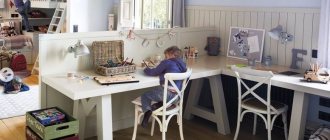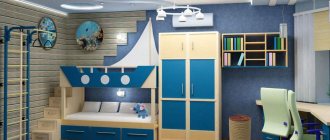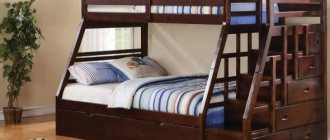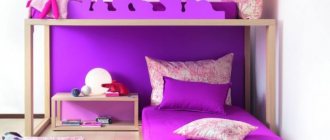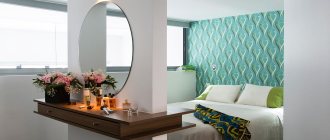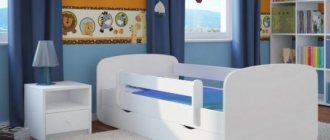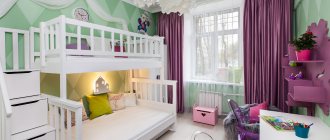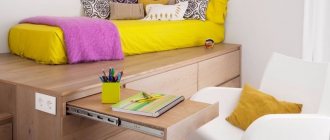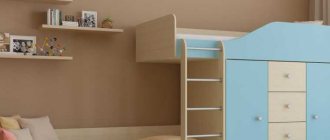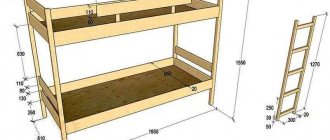What types of bunk beds can be distinguished?
The purpose of such beds is to rationally use the limited area of the room and create sleeping places for children. Modern bunk models can be designed for several children, one child, a child and parents. Today there are the following options for bunk beds for children:
- Standard classic bed , where there are two places to sleep, one of which is located above the other. These are just beds without additional attributes in the form of storage shelves, drawers, and cabinets. The disadvantage of such a bed in a small room is that it takes up a lot of space and is not very practical - it is just a place to sleep. However, if the area of the room allows you to purchase this option, then you should not refuse it.
Children's room with standard bunk bed
- Beds in which the sleeping places are also located one above the other , but at the same time there are steps in the form of retractable drawers for things and there is a place for storing bedding. This bed model is appropriate for small children's rooms; it captivates with its compactness and ability to rationally use the room.
Functional bunk bed with drawers
- The next type is sleeping places in which the upper place is not located directly above the lower one, but to the left or right. The resulting niche may contain a cabinet, shelves, or an empty wall, which the owners themselves will fill at their discretion.
Bunk bed with wardrobe
- Beds placed crosswise or perpendicularly. This option is both modern and very convenient: you can put a cabinet in the free space, hang shelves, or put a small table. A compact and interesting option for children is a transforming bed, in which the lower berth is pulled out at night and removed after sleep, freeing up space in the room.
Double bed with cross beds
Beds with two tiers for use by one child
There are several options for bunk beds with one sleeping place for children:
- A bed of two tiers, where on the top is where the child sleeps, and below it is a large bed for the parents. This is an option for small apartments where children and parents live in one room. The space savings in such conditions are obvious. However, to ensure the safety of small children on the upper tier, it is advisable to install sides along the edges.
Bunk bed for a one-room apartment
- The next option is a bunk bed with one sleeping place, which is located at the top. On the lower tier there is a child’s work area, with a desk, shelves and cabinets. Often such beds come complete with a small sports corner. There is a staircase, which can be either ordinary or in the form of steps from drawers.
Bunk bed for a children's room with a workplace
- Another option is a place for the child to sleep at the top, a wardrobe, chest of drawers, drawers or shelves below. The working and writing area is located separately.
Bunk bed with wardrobe for children's room
Bunk beds for two children
Bunk beds designed for two children will help create two full-fledged sleeping places, using the minimum area of the room. Typically, parents place older children upstairs, while younger children are assigned the safer ground floor. These bunk beds also come in several types:
Bunk bed for two children
- Compact, classic option - two floors with parallel beds located above each other with a vertical staircase. The option is similar to the previous one, but the sleeping places are shifted either to the left or to the right of each other, and there are wardrobes or a staircase in the free space.
Bunk bed for two children with parallel beds
- Perpendicular sleeping places, allowing you to compactly place a bed, a desk and a storage system for things in the children's room.
Bunk bed for two children with perpendicular sleeping arrangements
Bunk beds for parent and child
There may be several options here:
- two tiers, the lower one in the form of a folding sofa, and the upper one is a child’s sleeping place;
Bunk bed for parents and child
- a safer option for children: on top there is a large double bed for adults, below there is a full-fledged children's place.
Bunk bed with sleeping place for parents on top
These beds are suitable for small apartments, and the latter option is especially convenient for families in which the child is too small to sleep on the top tier. Such models can be found in many stores.
Transformable beds
Among bunk beds, it is necessary to highlight such an option as transforming beds:
Pull-out models in which the lower bed extends from the upper berth. This bed is compact and ideal for preschool children.
Transformable bunk bed for a children's room
Modern models in which an ordinary sofa turns into two high tiers with two sleeping places. Such transformable furniture can be found from some manufacturers. This unusual furniture option will be appreciated by teenagers, using a sofa during the day and sleeping places at night.
Transformable bunk bed
Types of children's beds on two levels
Everyone's concept of a bunk bed is different. Most consist of two ordinary berths on a metal or wooden frame. Of course, most beds are like this, but no one bothers you to diversify the interior of a children's room with a bunk bed, use your imagination and “play” with space.
Do not confuse a bunk bed, where there are two sleeping places, with a loft bed, where one child can sleep. Typically, in such models, the sleeping area is located at the top, and either a play area or storage space is located below.
So, we can note the main types of children's beds in two levels:
- The sleeping places are located one above the other;
- In the shape of the letter Z - the lower tier is slightly offset relative to the upper. More often, such placement can be seen in beds with a roll-out lower tier.
- In the shape of the letter L - the headboards of both berths form an L-shaped corner.
The first type of bed is a design where both sleeping places are located strictly one under one. Often such beds are made of a metal or wooden frame, without frills or special decor.
The disadvantage of such a two-level bed is that it is ordinary - in fact, it is just two sleeping places with no drawers for storing things. But such models are quite inexpensive and will come to the rescue of those parents who need a budget solution for sleeping for two children.
Sometimes children, especially those of the same age, can argue about dominance - who will sleep on the top tier. Usually, parents either make the decision themselves, separating the children, or allow the children to periodically change places.
Z-shaped bunk beds are a design where the lower berth is located with some offset relative to the upper one. Most often, this is an ordinary children's bed, where the lower tier extends like storage boxes, but instead of niches there is a mattress for sleeping.
Expert opinion
Stepanov Mikhail Filippovich
Designer of private and commercial interiors. 5 years of experience.
The advantage of such models is. that they are compact; if necessary, the lower level is hidden and the room becomes more spacious.
The disadvantage lies in the lack of a place to rest for the second child during the daytime.
In addition to retractable structures, there are also two-level beds, where the sleeping places are shifted not across, but along relative to each other. In this case, a chest of drawers or a linen closet is placed in the resulting free space on the lower level.
L-shaped beds with two tiers are a structure of two beds located perpendicular to each other. It is more convenient to place such a bed in the corner of the room, and place a chest of drawers, cabinets or other furniture for storing things in the free space under the upper tier.
Materials for making bunk beds
The most environmentally friendly, safe and fairly durable material for making children's beds has always been and remains wood. Pine or oak are considered ideal options; beech and birch can be alternative types of wood. Wooden surfaces can be painted in absolutely any color, perfectly fitting the design into the overall interior concept.
Now on sale you can find economy class bunk beds made of chipboard or MDF. The first option is far from ideal for a children's room, since it contains formaldehyde, which will evaporate in small doses in the room.
The second one is more preferable, stronger and safer than particle boards, and you can choose any color for painting MDF.
The most practical material for making bed frames, be it an adult or a children's model, is metal. Beauty and aesthetics in such models are always inferior to strength and reliability, but parents can be sure that the bed will serve their children for many years.
Especially when it comes to boys who love not only to climb onto the top tier, but also to jump on it.
On sale you can also find combined models in which the frame is made of metal, but there are colored inserts made of wood or MDF.
What to consider when choosing a bunk bed
In addition to the type and material from which the structure will be made, it is also worth considering several more requirements when purchasing:
- High quality processing . The model must be able to withstand the planned weight and be designed for a certain age of children. In addition, we must not forget about processing - edges and corners must be carefully sealed, cleaned and processed. There should be no burrs, uneven or sharp edges.
- The presence of sides on the upper tier. We deliberately indicated this requirement separately - such protection should prevent a child from falling at night from a height of at least 1.5 m. The height of the side should not be less than 25 cm.
- Durability and reliability of the design. Such characteristics largely depend on the material. Also, when choosing, you need to pay attention to the fastenings; therefore, the bed should not sway or wobble, withstanding significant loads from little fidgets. Reliability requirements also apply to the stairs leading to the upper tier.
- Distance between tiers. A child sleeping on the lower level should be able to sit quietly without banging their head on the upper level. The upper “floor” should also not be located too high so that the child does not touch the ceiling with his head.
- Color and design . The bed should not look like an unnecessary element in the interior of the nursery. You also need to take into account the gender of the children. For girls, give preference to pastel shades, for boys - more saturated ones. If it is assumed that there will be a bunk bed for two children of different sexes, then you should limit yourself to universal colors that match the overall interior.
- Easy to assemble . You should always be able to move the bed to another location. There are various situations in life when it is necessary to rearrange or remove furniture. Therefore, you should be able to take the bed apart and reassemble it.
A bunk bed designed in this spirit will be the ideal space for two boys.
Design of bunk beds
“Consider the color scheme of the bed: girls prefer to choose pastel, light and warm colors, boys choose colder and darker colors”
When purchasing and choosing a bunk bed for a child, be sure to take into account the child’s opinion and wishes, his gender, age, and hobbies. It is necessary to make sure that the child will be comfortable on such a bed, he will not be afraid of heights and the bed will be safe.
A bunk bed should be comfortable for a child
Consider the color scheme of the bed: girls prefer to choose pastel, light and warm colors, boys choose colder and darker colors. In any case, it is worth asking your child this question: perhaps the girl is very active, emotional and dreams of bright, exciting colors. Why not make her dream come true?
Children's room with an original bunk bed in the form of a house
For boys, a bunk bed with a sports theme is preferable, embodying ideas from cartoons and movies in a more strict, simple version compared to girls’ beds.
Children's bunk bed for boys' room
If children are of different genders, it is better to choose neutral shades that will suit both of them.
Bunk bed for a children's room for a boy and a girl
When choosing the color of the bed, regardless of the gender of the child, consider how it will fit with the rest of the room’s furnishings. Contradictions in design are unacceptable - the bed must fit harmoniously into the interior of the room.
The bed should be in harmony with the overall style of the room
High-tech style
Bunk beds in a modern and popular high-tech style are the embodiment of rationality and functionality, as well as strict, laconic forms and clear geometry.
Children's bunk bed in high-tech style
Romantic style
Girls prefer bunk beds for children in a romantic style. Such beds have rounded elements, delicate colors, decor and a variety of accessories. Bedding and textiles are also in muted, warm colors.
Bunk bed for a girl in a romantic style
Eco style
Eco-style is also popular now, using natural materials that are environmentally friendly for children. This style will be relevant for both kids and teenagers.
Children's bunk bed in eco style
Minimalism
But a style such as minimalism is more suitable for older children, since a bed in this style will be small in size and there will be a lot of space for a play area. In order to place a wardrobe, shelves, racks and at the same time gain space, it is wise to use combined bunk beds or transformable beds. These options are advantageous in small children's rooms.
Children's bunk bed in minimalist style
Materials used to make bunk beds
“The use of pine or beech wood is popular for making beds: it has proven itself to be durable, reliable and reasonable in cost.”
A children's bunk bed made of natural wood will fit perfectly into any style, from eco to pop art, for which the wood can be painted with bright colors.
Children's wooden bunk bed
For the manufacture of beds, the use of pine or beech wood is popular: it has proven itself to be durable, reliable and reasonable in cost, in comparison, for example, with oak. Wood is an environmentally friendly material that will last for many years.
Due to their environmental friendliness, wooden bunk beds are ideal for children's rooms.
When choosing, you should be careful, since manufacturers often use artificial materials instead of wood, and sellers “forget” to tell customers about this, thereby misleading them.
Bunk beds made of chipboard are attractive, but they are far from being so environmentally friendly: they contain formaldehyde, which will evaporate very slowly in the air and have a negative impact on health. When purchasing this option, you need to check with the sellers for a certificate that should indicate the level of formaldehyde in the product.
Children's bunk bed made of chipboard
It is difficult to choose a suitable metal bunk bed for a child’s room: the bed implies a modern style or minimalism, but it does not look very aesthetically pleasing. It should be noted that such a bed is reliable and durable, but at the same time quite heavy, and it will be difficult to assemble or disassemble it yourself.
Metal bunk bed in the interior of a children's room
When choosing such a bed, take care first of all about the safety of children: the corners must be processed, rounded, and sharp parts and fasteners must not protrude. Still, this is one of the most unsafe types of beds.
Photos of bunk beds for girls in the interior of a room
<
>
Extra space in small apartments is of great value. A children's bunk bed will help optimize the space of small rooms, freeing up space for games, study and other activities.
Convenience and safety
You can choose many beautiful, visually attractive options for bunk beds that suit the interior and design of the room, but we must not forget about the most important thing - the convenience and safety of the baby.
What should you consider when purchasing?
- 190 (180) x 90 cm is the optimal bed size for children. Smaller sizes, of course, can be chosen, but in this case it is necessary to understand that in a few years such a bed will simply be too small for the child.
Children's room with standard size bunk bed
- Strength is one of the important conditions. Children are active and mobile, and on the upper tier they can not only sleep, but also play, jump, and climb several at a time. Before purchasing, make sure that the bed does not sway or wobble and will withstand daily loads.
Make sure the bed is durable before purchasing
- Beautiful and comfortable. In the store, see for yourself how comfortable the beds are: you can sit on the bed and even lie down on it. If you are comfortable and convenient, then this option deserves attention. Pay special attention to the presence of protective sides on the upper tier, which protect the child from falling down at night. The sides should not be less than 25 cm, and it is also very desirable to have handrails on the upper floor.
The sides will protect the child from falling
The most important requirement for any household items in the room is their safety for children. For bunk beds, this condition should come to the fore. What do you need to consider?
- Age restrictions. Children from 6 years old sleep on the upper tier; for younger ages, for safety reasons, it is better to consider other bed options.
- A reliable, flat, stable staircase, with non-slip steps, securely fastened and ideally with railings.
Choose bunk beds with a stable, gently sloping ladder
- Distance between beds. Both children and adults should be able to sit comfortably; no one should touch the ceiling with their head.
- The top floor should also be optimal in height, especially if the nursery has low ceilings. The child should get up and down from the top tier and make the bed without inconvenience.
The second floor should not be located too close to the ceiling
- The bed must be assembled firmly and steadily, the legs must be securely on the floor, and all elements must be secured and tightly tightened.
- Durability that can be tested in a store by an adult. To do this, you need to climb onto the top tier and swing slightly. If you have the slightest doubt, it is better to refuse the purchase.
Durable bunk bed made of natural wood
- Bed mobility. When choosing, preference is given to structures that can be quickly assembled and disassembled. This will allow you to change sleeping arrangements in the future as the children grow older.
Rules for choosing a bed for teenagers
A high-quality double-decker bed for two teenagers has a reliable frame, a durable bed base and a comfortable orthopedic mattress. Parents must pay special attention to the safety level of furniture. In addition to high-quality stairs and fastenings, special fencing will be needed. The sides fix the mattress in the optimal position, protecting the child from falling. It is also recommended to take into account the height of the structure. On average it is 165-175 cm.
Frame
The frame of a bunk bed is made of metal, solid wood or composite wood. If your budget is unlimited, you should purchase beds with a hardwood frame (ash, cherry or oak). They are valued for their increased strength, excellent decorative effect and environmental friendliness. Beds made from laminated chipboard are cheap and practical. Metal furniture looks stylish, but it will have to be additionally secured to the floor.
<
>
Features of sleeping places
Solid and orthopedic (latoflex) bases allow you to create an excellent place to sleep. It must support the weight of a mattress and two children at the same time. The lower berth is often used as a sofa, that is, during the day children play on it together and receive guests.
The optimal bed size for a teenager is 180-190 cm in length, 50 cm in height and 90 cm in width. Orthopedic bases are preferable for children's beds, as they allow you to create comfortable conditions during sleep, improve the anatomical properties of the mattress and extend its life.
Requirements for the upper tier
Children who have reached school age should be allowed to sleep on the second tier. Sides and handrails are used to increase safety. It is not recommended to remove them, as they are additionally used to secure the mattress.
Rules for choosing a safe bunk bed:
- The second floor must support the weight of an adult.
- All fastenings must be secure.
- The optimal height of limiters with a length of 20 cm is 35 cm.
- There should be free space between the sleeping area and the ceiling.
During installation, special attention will have to be paid to the fastening mechanisms. The frame must withstand the constant load that occurs during children's games. Structural components are connected by bolts that are attached to the base of the bed or the wall in the case of built-in furniture models. Less commonly, frame elements are fastened with wooden locks, glue or welding. The frame manufacturer issues a quality certificate, which guarantees the safety of the furniture for the health of the child.
Stairs
The main design element of a bunk bed is a ladder made of metal, wood or thick ropes. Metal products are considered practical, but they are inferior in terms of safety to similar wood models. A reliable ladder is attached to the bed frame or mounted in the form of steps with railings. It is recommended to use monolithic, wide and angled structures with an anti-slip coating.
Mattress – what are they and which one is better to choose?
Since the size of a bunk bed for teenagers does not differ from the dimensions of a regular bed, the mattress should be selected according to biometric and orthopedic criteria. In addition to expert recommendations, the needs of children are taken into account, including their age, height and weight.
Recommendations for choosing a mattress:
- Orthopedic systems help relax muscles. The use of such products ensures the prevention of serious spinal diseases.
- For a growing organism, you should use an elastic sleeping place with an independent spring block. During rest, the body will occupy the correct anatomical position. A springless latex mattress would also be a good option. This filler is designed to follow the contours of the sleeper's body.
- Environmentally friendly, breathable and hypoallergenic materials should be used as filling and upholstery. Synthetics should be avoided.
- The dimensions of the bed directly depend on the size of the bed base. Teenagers grow quickly, so you can purchase a mattress model with a small margin.
- If a child has weight problems, the process of buying a mattress becomes much more complicated. For overweight children, you should buy hard products with a block of reinforced springs, while thin teenagers should choose soft mattresses.
You shouldn't skimp on buying a mattress. Although environmentally friendly filler, an independent spring block and a removable cover increase the cost, the quality of sleep will depend on the quality of the sleeping place.
Photo gallery - children's rooms with bunk beds
0509-CO-WH01.04
